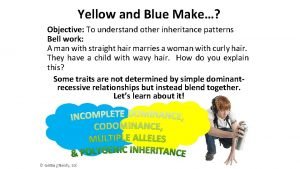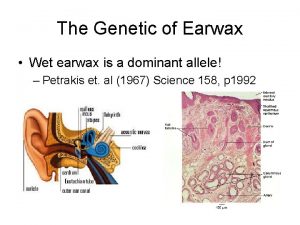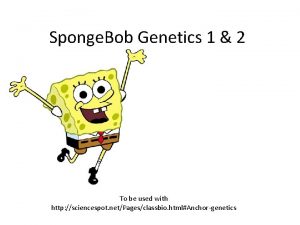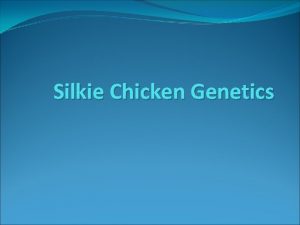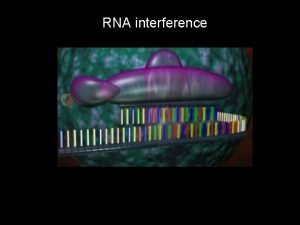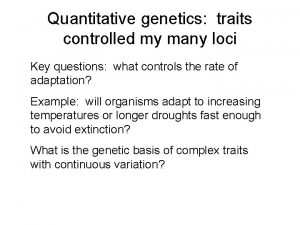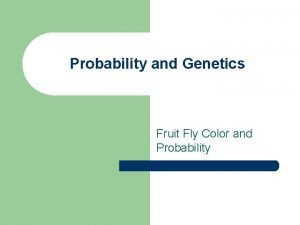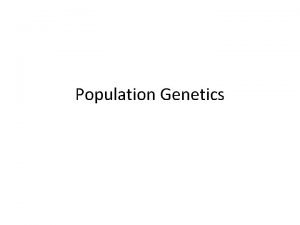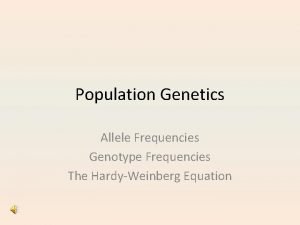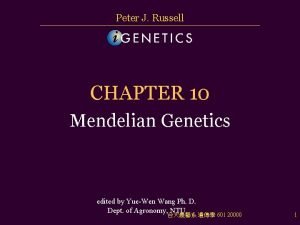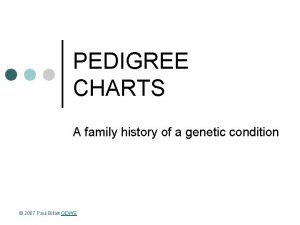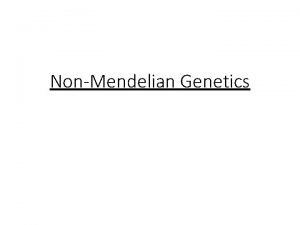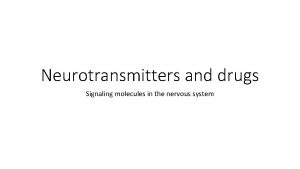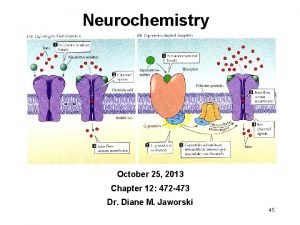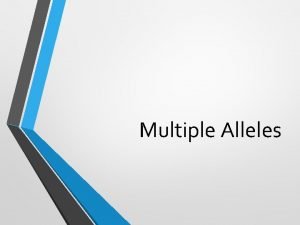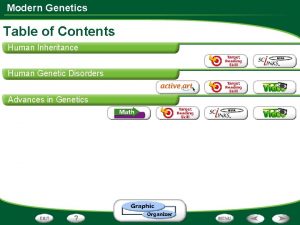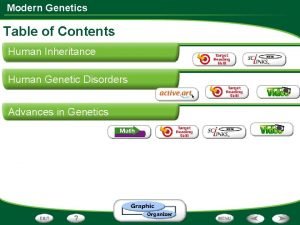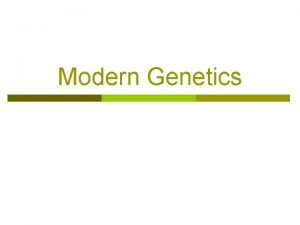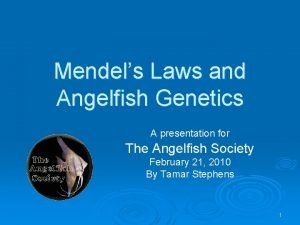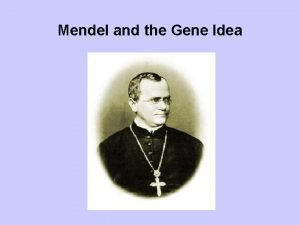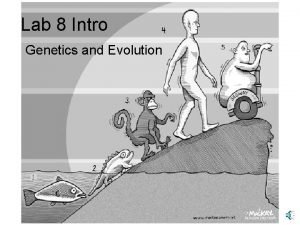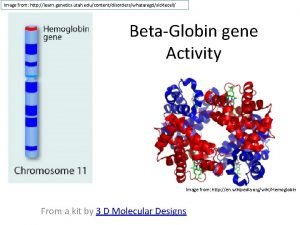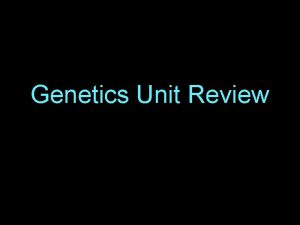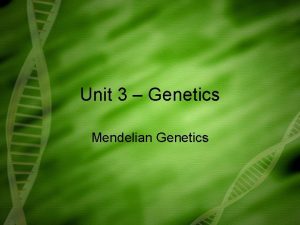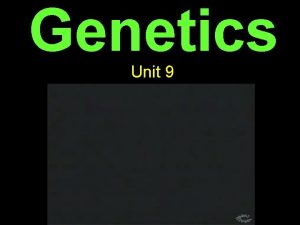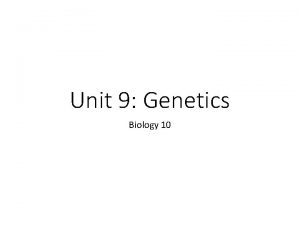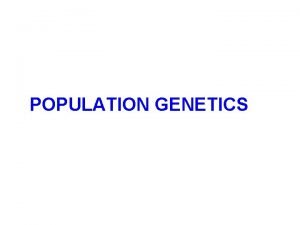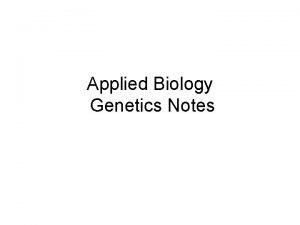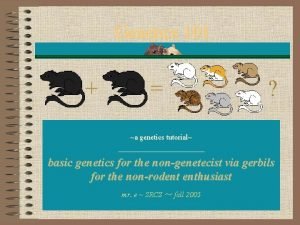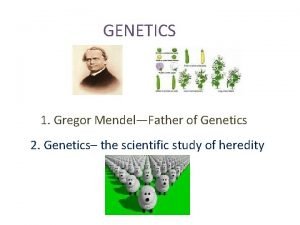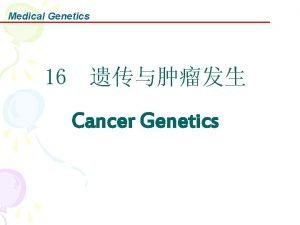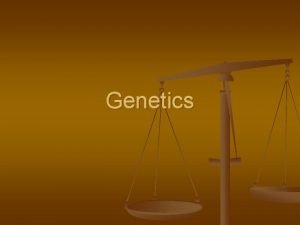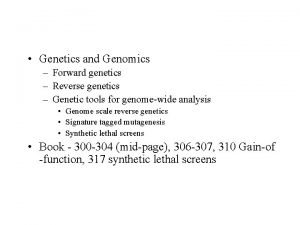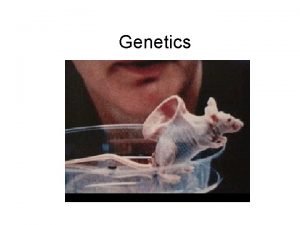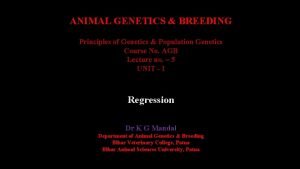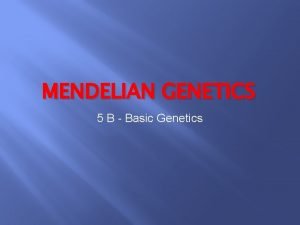Genetics Unit 6 What is genetics Genetics Is





































- Slides: 37

Genetics Unit 6

What is genetics? Genetics: Is the science of heredity • Genetics began with Mendel • Mendel is considered the “Father of Genetics” • Mendel was a monk who experimented with pea plants to study heredity

What is a trait? Trait: Is a notable feature or characteristic in an organism • Physical traits – Examples - Hair color, eye color, & height • Behavioral traits – Example – Sheepdog has herding instincts • Medical conditions – Examples – Cancer, Sickle cell, cystic fibrosis

Why did Mendel study peas? • Peas reproduce and grow quickly • They had easy to observe traits • Can reproduce using 2 different plants or using 1 plant – True-Breeding: Can produce offspring with only 1 parent Cross Pollination – 2 parents self-fertilizing/true-breeding

What are alleles? Allele: Alternative form that a single gene may have for a particular trait. (huh? ) A gene in a particular place on a particular chromosome will express a particular trait…. like flower color Purple is an Allele coming from mom Chromosome from MOM Chromosome from DAD But what color will the offspring show? White is an Allele coming from dad

How do alleles determine what traits will show? Some alleles are dominant and others are recessive Do you have to remember which Dominant: A trait that will appear (show) * traits Represented a CAPITALand letter which are with dominant Example: Tall (T), Black (B), Brown (B) recessive? . . . NO… Recessive: A trait that is masked (hidden) if a dominant allele is present, but will show if both Punnett Square questions will give alleles are recessive * Represented with lower letter you clues orawill tellcase you in the Example: blond TO (b), READ! blue (b) question!short You(t), HAVE

I do you know a trait will show or not? Rule #1: If there is a dominant trait present, it will always show that trait. Tall is dominant over short Capital “T” bosses the little “t” TT Dominant Shows Tall Tt Dominant Recessive Shows Tall

I do you know a trait will show or not? Rule #2: If there is NOT a dominant trait present, then the recessive trait will always show. Tall is dominant over short tt Recessive Shows Short

Clicker Question #1 Who is considered the “Father of Genetics”? a. Darwin b. Hooke c. Mendel d. Paquin

Clicker Question #2 These plants were used in Mendel’s experiments because they grow & reproduce quickly: a. b. c. d. Peas Corn Wheat Roses

Clicker Question #3 What is true-breeding? a. 2 parents reproduce offspring b. 2 offspring with three parents c. Self fertilizing plants d. Cross pollinating plants

Clicker Question #4 Tall is dominant over short If a girl has Tt, she will show: a. Short b. Tall c. Both (a) & (b) d. None of the above

Before we start Punnett Squares, we have a few more things to learn…

What are some terms that will help with understanding Punnett Squares? Homozygous: Organism with 2 of the same alleles for a particular trait. Also called “pure”. Examples – TT tt DD dd Same sized Same letters! sized letters! Homo means: ____ Same Think: Same SIZED letters

What are some terms that will help with understanding Punnett Squares? Heterozygous: Organism with 2 different alleles for a particular trait. Also called “hybrid”. Examples – Tt Dd Gg Bb Different sized Different letters! Different sized letters! Hetero means: _____ Different Think: Different SIZED letters

What are some terms that will help with understanding Punnett Squares? Phenotype: The observable characteristic or outward expression of an allele pair Characteristics you can see with your eyes! Think: Phenotype -- Physical Blond Hair Black Hair Red Hair Brown Hair

What are some terms that will help with understanding Punnett Squares? Phenotype Characteristics you can see with your eyes! Multi color Butterfly Blue Butterfly White Butterfly Orange Butterfly

What are some terms that will help with understanding Punnett Squares? Genotype: The organism’s allele pairs Characteristics you can NOT see with your eyes! Think: Genotype – Genetic Code GG bb HH Gg gg BB Bb Hh hh

Clicker Question #5 Another term for heterozygous is: a. Allele b. Same c. Hybrid d. Pure

Clicker Question #6 tt is an example of: a. homozygous b. heterozygous c. hybrid d. all of the above

Clicker Question #7 tt is an example of: a. phenotype b. heterozygous c. hybrid d. genotype

Clicker Question #8 Tall is dominant over short If a boy has tt, he will show: a. tall b. short c. both (a) & (b) d. none of the above

Clicker Question #9 Tall is an example of: a. phenotype b. Heterozygous c. pure d. genotype

What is Mendel’s Law of Segregation? Law of Segregation: States that the two alleles for each trait separate during meiosis. During meiosis, the alleles separate During fertilization, the alleles unite into a pair again

What’s the difference between monohybrid ? & dihybrid crosses? Punnett Square: A diagram used to predict the possible outcomes (offspring) of a particular cross or breeding. Monohybrid Cross: The use of Punnett Square for 1 trait (will have 4 boxes)

Punnett Square Video

What’s the difference between monohybrid ? & dihybrid crosses? Dihybrid Cross: The use of Punnett Square for 2 traits (will have 16 boxes)

What’s the difference between monohybrid ? & dihybrid crosses? Law of Independent Assortment: Mendelian law stating that two alleles for each trait separate during meiosis During Dihybrid crosses: The random assortment of alleles results in four possible gametes…each of which is equally likely to occur I will show you this when I show dihybrid crosses

Sometimes two traits can be dominant at the same time

What’s the difference between incomplete dominance and co-dominance? Incomplete Dominance: Complex inheritance pattern in which the heterozygous phenotype is intermediate between those of the two homozygous parent organisms…huh? Mixes like paint! R R W RW RW

What’s the difference between incomplete dominance and co-dominance? Co-Dominance: Complex inheritance pattern that occurs when neither allele is dominant and both alleles are expressed. B W W B BW BW

Clicker Question #10 Each gamete has only one allele for a trait because of: a. recessive b. Law of segregation c. dominance d. phenotype

Clicker Question #11 When a white flower & a red flower have pink offspring, this is because of: a. b. c. d. Co-dominance Law of segregation Law of Independent assortment Incomplete dominance

Clicker Question #12 In speckled chickens, both alleles are express because of: a. Co-dominance b. Law of segregation c. Law of Independent assortment d. Incomplete dominance

Clicker Question #13 The cross with one trait is called: a. Dihybrid b. Trihybrid c. Monohybrid d. All of the above

Clicker Question #14 A dihybrid cross will have how many squares? a. 4 b. 16 c. 18 d. 20

Lets start Punnett Squares!
 Unit 10, unit 10 review tests, unit 10 general test
Unit 10, unit 10 review tests, unit 10 general test Suatu lembaga yang
Suatu lembaga yang Right triangle trigonometry
Right triangle trigonometry English unit conversions
English unit conversions Algebra 2 unit 1 test answers
Algebra 2 unit 1 test answers Contoh soal perhitungan unit cost rumah sakit
Contoh soal perhitungan unit cost rumah sakit Unit process and unit operation
Unit process and unit operation Unit operation and unit process
Unit operation and unit process Kerangka konseptual akuntansi pemerintahan
Kerangka konseptual akuntansi pemerintahan Getting nerdy llc genetics you're such a square answer key
Getting nerdy llc genetics you're such a square answer key Earwax type genetics
Earwax type genetics Susie roundpants
Susie roundpants Silkie color genetics
Silkie color genetics Sexual reproduction and genetics section 1 meiosis
Sexual reproduction and genetics section 1 meiosis %22ds-5%22%20development%20studio
%22ds-5%22%20development%20studio Genetics model
Genetics model Genetics
Genetics Probability in genetics
Probability in genetics Learn.genetics.utah/content/addiction/mouse
Learn.genetics.utah/content/addiction/mouse Population genetics
Population genetics Allelic frequencies
Allelic frequencies Branch diagram for trihybrid cross
Branch diagram for trihybrid cross Blood pedigree
Blood pedigree Multiple alleles
Multiple alleles Http://learn.genetics.utah.edu/content/addiction/
Http://learn.genetics.utah.edu/content/addiction/ Http://learn.genetics.utah.edu/content/addiction/
Http://learn.genetics.utah.edu/content/addiction/ Blood type codominance practice problems
Blood type codominance practice problems Human inheritance modern genetics answer key
Human inheritance modern genetics answer key Genetics graphic organizer
Genetics graphic organizer Modern genetics human inheritance answer key
Modern genetics human inheritance answer key Angelfish genetics
Angelfish genetics Mendel monk
Mendel monk Chapter 10 sexual reproduction and genetics
Chapter 10 sexual reproduction and genetics Multiplication and addition rule genetics
Multiplication and addition rule genetics Similar
Similar Section 11-5 linkage and gene maps answer key
Section 11-5 linkage and gene maps answer key Learn.genetics.utah.edu
Learn.genetics.utah.edu 14-3 human molecular genetics
14-3 human molecular genetics









